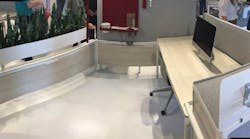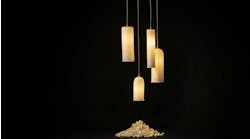Rather read the transcript?
[Start transcript]
Christoph Trappe: Hello, everyone. Again, it’s Christoph Trappe, chief content officer with Interiors+Sources and Buildings.com.
So, we’re here, still at NeoCon and now at the Watson suite and joined by Cia Mooney, chief design officer at Watson. Cia, thanks for joining us.
Cia: Thank you very much.
Then when they grow, they put another row on the other side. Now they face each other. So, you have to look at somebody for the rest of the day. And then the more they grow, the closer the rows get pushed together. It’s like an airplane, except worse.
That is not the answer.
Cia: No, it’s not the answer, but it is a necessity of growth to put people together in very tight quarters.
Christoph: So, as we were touring your suite, you were talking about some of the solutions on how you help companies grow, and also, give employees a good experience in the workplace, especially the open workspace.
Cia: Well, we thought the open plan was due for an overhaul. And when we looked at it, we wanted to bend space to people. Respond to the human condition inside of the open plan where there’s a loss of focus and privacy. And we did that through bending the power rail.
As a company grows, they can create what we call “generous density” by opening up the workstation. And then as they grow and they need to densify, we can reorient the desk and the rail, simply by bending it. And that is an innovation unique to Watson. We have a patent pending on that system.
Christoph: And that’s, of course, if you are listening on iTunes, Spotify, one of those channels, we have pictures on Interiorsandsources.com of this new product.
And is it brand new for NeoCon?
Cia: It is brand new for NeoCon and we joined that to our height-adjustable table called Cloud9, that was designed by Morten Nikolajsen of Mohoni Studios in Svendborg, Denmark. And that language, a very beautiful, reductive European language, is built around a four-leg table system that opens up the space underneath the desk. And the storage travels with the desk.
So, we’ve tried to remove objects from the floor to give a sense of graciousness and openness while also improving the workstation itself with the new power rail.
We have three levels of privacy that we’ve imported into the power rail. And that is planter boxes, slices, which are metal screens and then opaque textile screens. And that’s all about giving folks a different landscape and topology.
Christoph: Very interesting. And so, as companies grow, how do you help them, especially when they grow? I mean I don’t even know what a big number is. Dozens of employees, a hundred, 200? I guess there’s different growth spurts for companies. How do you help them make sure they still have that good environment?
So, architects are under pressure to revamp buildings, real estate professionals are under pressure to find good headquarters. We as furniture providers are under pressure to create systems that can flex over time.
The importance is to try and give back to the employees, a little bit of graciousness. That could be in the work tools, it could be in the desk, it could be in how space is divided.
But by allowing companies to have mobile desks, mobile carts, desks of varying sizes and shapes, it allows them to stay pretty agile.
And then we know that they have to manage all those assets ultimately. So, we try and strip all the unnecessary parts out of the product, so they don’t have to worry about which screw goes with which thing.
Christoph: That’s always good to know, especially for a guy like me who doesn’t want to put anything together.
Cia, thanks for joining us. Of course, we already touched a number of different solutions for the open office, I call it open office dilemma. And here’s another one for your consideration.
Thanks everyone for listening. Christoph Trappe, interiorsandsources.com and Buildings.com.
[End transcript]
More NeoCon 2019 Coverage: Multiple Meanings of Kirei: Clean, Green and Beautiful Design


